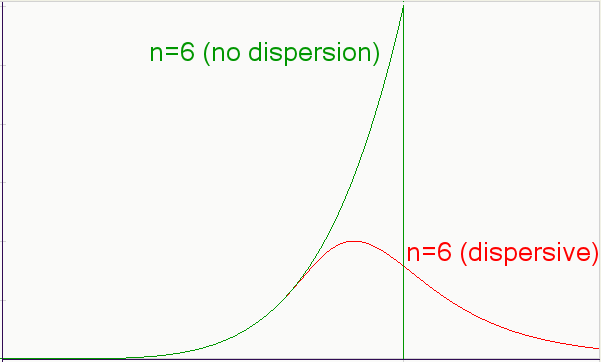Kasus ini menarik untuk dipelajari karena pada proses tender ini, investor diberikan opsi untuk keluar dari proyek tersebut, jika eksplorasi yang dilakukan selama dua tahun tidak menghasilkan apa-apa sebagaimana tergambar dibawah ini.

Jika cadangan yang ditemukan memadai dan investor setuju untuk mengembangkan tambang ini, maka investor harus memberikan komitment berapa investasi yang akan dikeluarkan. Apabila investor nantinya tidak mencapai target investasi yang pernah dijanjikan maka pemerintah Peru akan memberikan penalty kepada investor sebesar 30% atas selisih antara realisasi biaya pengembangan yang terjadi dan komitmen awalnya.
Dalam tender ini, peserta tender diminta untuk mendaftarkan proposal penawarannya yang meliputi jumlah uang yang akan dibayar untuk pengikatan kontrak serta jumlah investasi yang akan mereka janjikan jika tambang itu akan dikembangkan.
Disinilah yang menjadi tantangan bagi peserta tender, apakah akan memperbesar jumlah uang yang harus dibayar awal ataukah jumlah komitmen investasi yang akan mereka bayarkan.
Pada saat pertama kali diumumkan, ada lebih dari 40 perusahaan yang tertarik untuk masuk dalam tahap prekualifikasi. Dari jumlah ini, 12 perusahaan dari Canada, Afrika Selatan, Inggris dan Jepang yang memperlihatkan keseriusan dan melakukan “data room”. Pada tahap akhir, hanya tiga perusahaan yang mendaftarkan proposalnya yaitu RTZ-CRA (sekarang Rio Tinto), Noranda, dan joint venture Inmet Mining – Rio Algom.
Sedikitnya informasi geologi dari tambang ini, menyebabkan tingginya ketidakpastian dari proyek ini. Data yang digunakan untuk penilaian kasus ini adalah sebagai berikut :
 Adapun data lainnya diambil dari pasar keuangan yaitu data harian dari London Metals Exchange (LME) untuk periode Septermber 1991 sampai Juli 1996 yang digunakan untuk menentukan parameter dari model harga logam.
Adapun data lainnya diambil dari pasar keuangan yaitu data harian dari London Metals Exchange (LME) untuk periode Septermber 1991 sampai Juli 1996 yang digunakan untuk menentukan parameter dari model harga logam. Disamping itu dari pasar keuangan diperoleh data korelasi return untuk tembaga dan seng beserta “convenience yields”nya masing-masing. Semua korelasi untuk data harian untuk periode September 1991 - July 1996.
Disamping itu dari pasar keuangan diperoleh data korelasi return untuk tembaga dan seng beserta “convenience yields”nya masing-masing. Semua korelasi untuk data harian untuk periode September 1991 - July 1996.
Berdasarkan data-data diatas kita dapat lakukan suatu simulasi model stochastic selama 24 bulan (2 tahun) dari tahun 1996 dimana pada akhir tahun 1998, diasumsikan kita akan masuk dalam kontrak “forward” pada saat kita akan memproduksi mineral ini sehingga kita terlindung dari fluktuasi harga logam ini di pasaran.
Dengan mengambil basis 1996 sebagai tahun evaluasi dan asumsi bahwa probabilitas untuk masing-masing skenario adalah sebagai berikut :
1. Skenario “low” = 20% dengan investasi sebesar $581MM
2. Skenario “base” = 40% dengan investasi sebesar $602 MM
3. Skenario “high” = 20% dengan investasi sebesar $622 MM
maka diasumsikan kita akan mendapatkan hasil NPV pada tahun 1996 sebagai berikut :
1. Jika tidak ada asumsi untuk abandon project ditahun 1998 maka NPV = $1,425 MM
2. Jika ada asumsi untuk abandon project ditahun 1998 maka NPV = $1,525 MM
Dengan melihat kondisi diatas, terlihat bahwa opsi untuk melakukan abandon di tahun 1998 mempunyai nilai sebesar $100 MM.
Dari proses tender ini ada tiga perusahaan yang mendaftarkan proposal penawarannya yaitu :
RTZ-CRA Ltd, menawarkan $17.5 M sebagai pembayaran awal dan $900 M sebagai komitment investasi
Noranda menawarkan dengan jumlah yang sama yaitu $17.5 M sebagai pembayaran awal dan $1,900 M sebagai komitment investasi
Perusahaan kecil, Aliansi Rio Algom/Inmet menawar dengan $20.0 M sebagai pembayaran awal dan $2,500 M sebagai komitment investasi
Berdasarkan proposal dari tiga bidder maka pemerintah Peru akan menerima bid sebagai berikut :
 Dari 3 penawaran diatas, terlihat bahwa Aliansi Algom/Inmet berhasi memenangkan tender ini dengan harga tawar yang paling tinggi.
Dari 3 penawaran diatas, terlihat bahwa Aliansi Algom/Inmet berhasi memenangkan tender ini dengan harga tawar yang paling tinggi.Sekarang mari kita analisa apakah pemenang tender ini memberikan penawaran yang tidak wajar.
Jika kita asumsikan nilai PV diluar investasi dan penalti serta investasi yang terjadi adalah sebagai berikut :
 Jika kita lihat hasil akhir keekonomian dari tiga proposal bidder ini adalah :
Jika kita lihat hasil akhir keekonomian dari tiga proposal bidder ini adalah : Dilihat dari hasil akhirnya terlihat bahwa hasil yang diharapkan Rio Algom/Imment adalah 50% lebih kecil dibandingkan dengan RTZ-CRA, namun demikian keuntungan ini masih diatas $1,000 MM.
Dilihat dari hasil akhirnya terlihat bahwa hasil yang diharapkan Rio Algom/Imment adalah 50% lebih kecil dibandingkan dengan RTZ-CRA, namun demikian keuntungan ini masih diatas $1,000 MM.Yang menarik adalah pernyataan dari eksekutif Rio Algom/Imment pada hari yang sama saat diumumkan jadi pemenang, bahwa mereka hanya akan membelanjakan sekitar $1,000 MM untuk mengembangkan tambang Antamina. Pernyataan mereka adalah "If it does not prove viable, we just lose our up-front investment”.
Disini jelas bahwa, mereka sangat mengenal adanya “options” yang ada dalam aturan tender tersebut. Ini mengindikasikan mereka tidak akan berencana berinvestasi sebesar $2,500 MM melainkan hanya sekitar $1,000 MM termasuk didalamnya penalty. Mereka tampaknya ingin memberikan pemahaman kepada analist sekuritas bahwa mereka tidak “overpaid” pada tambang tersebut. Mereka secara jelas mengerti bentuk opsi dari penawaran ini.

